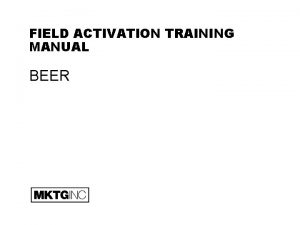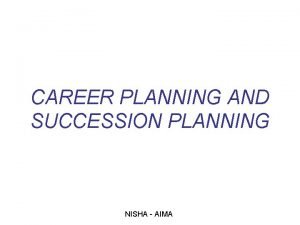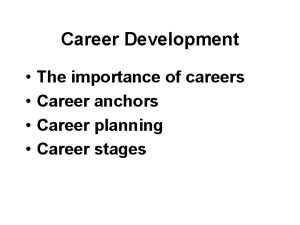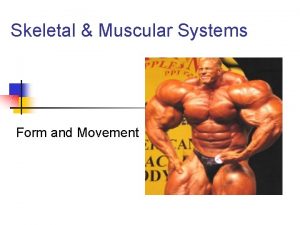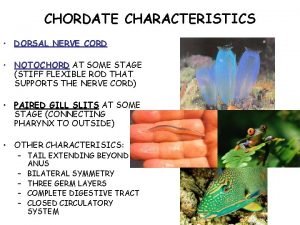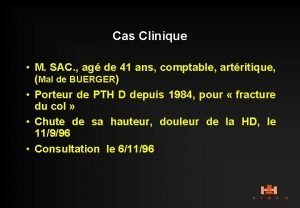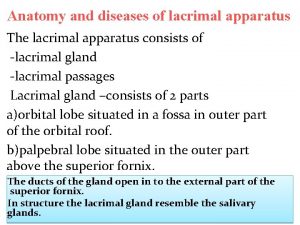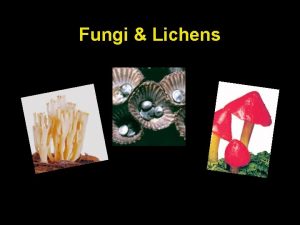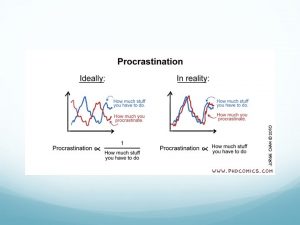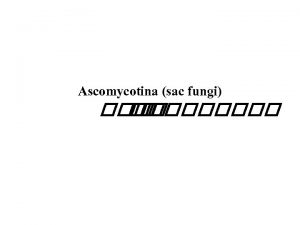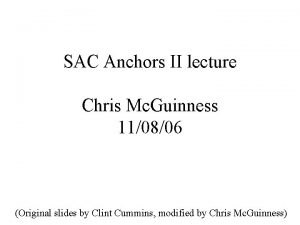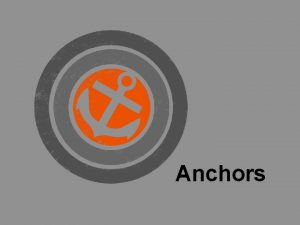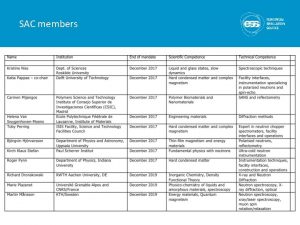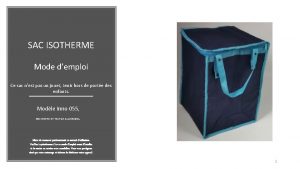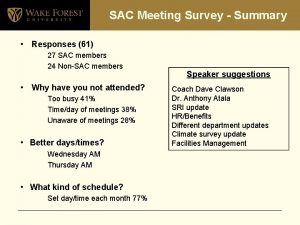SAC Anchors II lecture Chris Mc Guinness 110806



















































- Slides: 51

SAC Anchors II lecture Chris Mc. Guinness 11/08/06 (Original slides by Clint Cummins, modified by Chris Mc. Guinness)


What we’ll cover • • • 0. Knots 1. Placing Gear 2. Constructing Gear Anchors 3. Multipitch Climbing Sequence 4. Multiple Rappels 5. Where to go from here (transition from toprope/bolted to gear climbing)

What we won’t cover • Actual climbing techniques (jamming, chimneying, etc. ) • Leading

0. Knots • • Overhand on a bight figure-eight on a bight water knot Double fisherman girth hitch clove hitch Munter hitch prusik




Double Fisherman

Clove Hitch


1. Placing Gear • General concerns: • rock quality (hardness, fractures / thin flakes / loose pieces, sand/dirt/leaves/moss/grass) • surface area contact • direction of pull • ease of removal


Gear types • Fixed: – Trees – Rocks (horns/boulders, tunnels) – Bolts + Pitons • Removable: – Nuts (Stoppers, Hexes) – Cams (Camalots, Friends, TCUs, Aliens) – Tri-Cams

Trees • Preferably living • Ideally the size of your leg • Sling as low down as possible

Horns, Flakes, Tunnels • Pay special attention to rock quality • Girth hitch feature securely, and be aware of the possibility of the sling getting pulled up by the rope

Fixed Gear • Inspect gear before just clipping – Pitons get old, rusty and can break – Fixed nuts are often not as fixed as they appear • Generally a visual inspection, followed by a good tug while observing if the piece wiggles around is sufficient

Bolts From ASCA (American Safe Climbing Association)

Hex nut - surface area

More Hexes

Stopper - sizing + orientation

Cam - placing or removing

Camalots - selecting size Good - Strong + stable Not so good - unstable Bad

Friends - selecting size good Not so good bad

Friend sizing - smaller crack Too tight (hard to remove) good Not so good

Clipping gear in anchor or lead • Orient biner so gate does not touch rock • Do not load biner over rock edge - use sling • Do not girth hitch sling directly to cable of nut or narrow bolt hanger - could be cut • Do not load solid shaft of Friend over edge • Avoid loading cable of TCU over rock edge - could be bent permanently


Tri-Cams

2. Constructing gear anchors • SRENE = – Solid (invididual placements) – Redundant (independent) – Equalized – No Extension (if piece fails) • Add: – Efficient (simple, fast) – Stable (robust to movement / changes)


Standard placement counts • 3 strong placements, at least one multidirectional for lead anchor • say 1/100 chance of random failure due to unobserved factors. If placements are independent, then: • 1/10, 000 chance of failure for 2 placements • 1/1, 000 chance of failure for 3 placements

# of anchor pieces - exceptions • 2 “good” bolts: • good = 5/16” or larger, not rusty • suspect = surface/smooth rust or 1/4” • bad = corroded/pitted rust and 1/4” • 1 -2 good trees (still use 2 slings/biners) • more than 3 pieces? Too complex, unless some are weak; violates Strong rule, but is sometimes unavoidable

Joining pieces A: Clove hitch

Joining pieces B: slings

Joining pieces C: Cordelette

Joining Pieces D: Equalette

Joining placements in anchor • A. Clove hitches on climbing rope • +: strong, quick, no extra gear needed • -: questionable equalization, must retie if not swinging leads • B. Slings (with knots or clove hitches to adjust) • +: good for toproping, 1 -2 points to clip on leads • -: reduces slings available for next lead, hard to equalize well • C. Cordelette • +: single point to clip, good for leading in blocks • -: requires carrying extra 1 -2 pieces of gear, may not be long enough to reach all placements • D. Equalette • +: Same advantages as cordelette, but better equalization • -: Takes additional time if limiter knots must be retied


3. Multipitch climb sequence • Safety on approach (rope up on demand) • Tie in and check knots/harnesses • Bottom anchor if exposed ledge, leader outweighs follower, or ledge fall possible • Location of belay anchor (to side) • Clipping to belay anchor • 2 Clove hitches, or Daisy chain + 1 clove

3. Multipitch sequence (cont’d) • Stacking belay rope (and second rope) • Lead belay position • Feed out rope; some slack for quick clips • Space to bring braking hand to side/back





Special risk - Factor 2 Fall • Problems: • A. High force on belay anchor - could fail • B. Difficult to hold leader fall. Friction of rope running over biner makes 50% easier! • Solutions: • A. Clip rope through quickdraw on anchor • B. Leader places 1 -2 strong pieces early

4. Multiple rappels • Four main risks: • A. Rappel anchor fails • B. Rappel off end of rope (sometimes due to uneven length ropes) • C. Loose rock knocked by rope onto climbers • D. Ropes hang up during pull




Munter Hitch

5. Where to go from here • Transition from toproping / bolted climbing to gear climbing • Practice placing gear • Practice crack climbing skills • Make a list of climbs you want to do • Find partners with similar abilities and goals (or more experienced, occasionally) • Start leading easier climbs
 Omental (epiploic) foramen
Omental (epiploic) foramen Double layer peritoneum
Double layer peritoneum Paracolic gutter
Paracolic gutter Structure of lesser omentum
Structure of lesser omentum Guinness fabrication
Guinness fabrication Guinness the 1798 limited edition
Guinness the 1798 limited edition T distribution vs z distribution
T distribution vs z distribution Anchors away play
Anchors away play Aircraft tie down procedures
Aircraft tie down procedures Types of career anchors
Types of career anchors Behavioral anchors for competencies
Behavioral anchors for competencies Types of career anchors
Types of career anchors What is concrete edge breakout
What is concrete edge breakout Stores minerals and anchors muscles
Stores minerals and anchors muscles 01:640:244 lecture notes - lecture 15: plat, idah, farad
01:640:244 lecture notes - lecture 15: plat, idah, farad Dorsal nerve cord vs notochord
Dorsal nerve cord vs notochord Conjunctival sac
Conjunctival sac Sac gestationnel tonique
Sac gestationnel tonique Sac gestationnel 9mm
Sac gestationnel 9mm A sac shaped like an upside down pear with a thick lining
A sac shaped like an upside down pear with a thick lining Fungal life cycles
Fungal life cycles Gynglyme
Gynglyme Sac sed arauca
Sac sed arauca French feminine and masculine nouns
French feminine and masculine nouns Cul de sac uterus
Cul de sac uterus What are the characteristics of fungi
What are the characteristics of fungi East sac county elementary school
East sac county elementary school Wilms tümörü nöroblastom ayrımı
Wilms tümörü nöroblastom ayrımı Anterior cul de sac
Anterior cul de sac Sac no embryo
Sac no embryo Normal sd ratio
Normal sd ratio La clinique du sac
La clinique du sac Achch
Achch Disease of lacrimal apparatus
Disease of lacrimal apparatus Mt sac website
Mt sac website Characteristics of club fungi
Characteristics of club fungi Saç klonlama
Saç klonlama Mt sac bog waiver
Mt sac bog waiver Spermatic cord coverings
Spermatic cord coverings Sac explorar cauda longa
Sac explorar cauda longa Sac sl
Sac sl Hepatic bursa
Hepatic bursa Mt sac psych tech
Mt sac psych tech Pmi sac
Pmi sac Sac blackboard
Sac blackboard Dental papilla
Dental papilla Mt sac flight school
Mt sac flight school Yemek yeme beceri analizi örnekleri
Yemek yeme beceri analizi örnekleri Sac uw madison
Sac uw madison Sac fungi domain
Sac fungi domain What is wrong here
What is wrong here Sac valley medshare
Sac valley medshare





